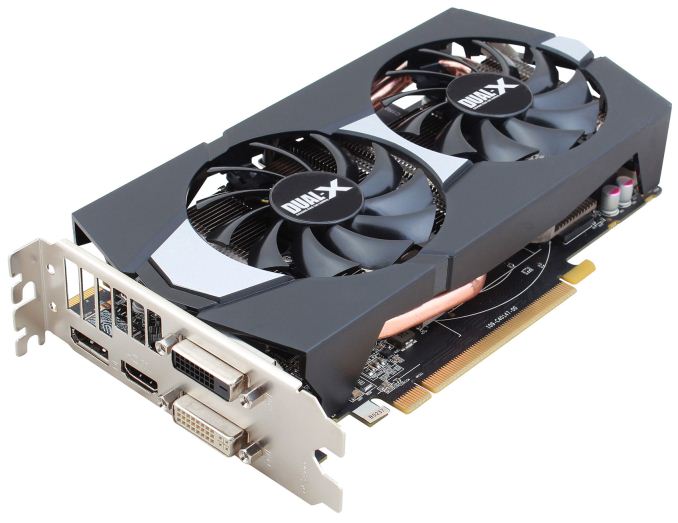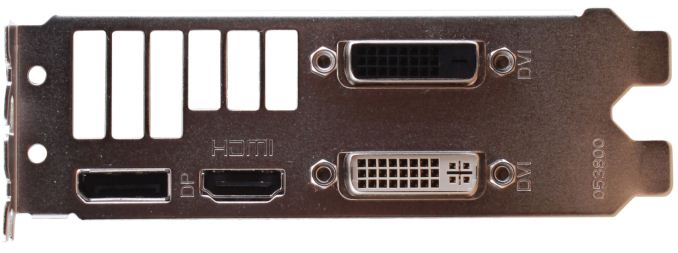The AMD Radeon R7 265 & R7 260 Review: Feat Sapphire & Asus
by Ryan Smith on February 13, 2014 8:00 AM ESTMeet The Sapphire Radeon R7 265
Since the R7 265 is a variant of the existing R7 270 series, AMD isn’t creating a reference card this time around. In lieu of that they have been sending the press Pitcairn cards reprogrammed to the 265 specification, which gives us something suitable to test but doesn’t necessarily represent what the final retail products will look like. For our sample we received a board based on Sapphire’s Radeon R9 270 Dual-X design.
Because we don’t know at this time whether this specific card will be a retail product or not, we’re not in a position to talk about it in depth. But we did want to discuss it briefly, as we expect most (if not all) retail R7 265 cards to be built in a similar manner, especially for the board partners reusing their existing R9 270 designs as was the case here.
Sapphire’s design is fairly typical for a 150W AMD card. Here Sapphire utilizes a compact form of their Dual-X cooler, relying on a pair of 75mm fans mounted over an aluminum heatsink, with a pair of copper heatpipes providing a connection between the heatsink and the Pitcairn GPU underneath. A baseplate brings the package together, providing cooling for the RAM and VRMs, relying on small grooves at various areas to function as a quasi-heatsink and improve convection. This means that it is of course an open air design, and while 150W is not trouble for most cases these days it does bear mentioning.
Sapphire’s Dual-X cooler runs 8.5” long, causing it to slightly overhang the 7.9” PCB. The card doesn’t feature a dedicated stiffening mechanism of any kind, but the baseplate is just large enough to provide the necessary rigidity on its own. Elsewhere the required 6pin PCIe power socket is located at far end of the PCB, orientated parallel to the PCB itself and slightly obscured by the card’s shroud; so you’ll need a bit more room behind the card to work in the necessary power cabling.
Finally, at the front end of the card we find half slot vent, coupled with AMD’s current generation I/O layout of 1x DisplayPort, 1x HDMI, and 2x DL-DVI. Notably, Sapphire has also added themselves to the pool of board partners with this design by using a wider grating spacing in an attempt to improve airflow, subdividing their vent into just 6 relatively large segments.













52 Comments
View All Comments
edzieba - Thursday, February 13, 2014 - link
It's not just a tool for flagging up multi-screen/multi-GPU stutter issues. By showing the distribution of frame times, you can tell the difference between two cards that both average 50fps, but where one delivers every frame in 20 +/- 1 ms, and the other at +/- 5. The latter will deliver a much smoother output, which is not apparent from a single-number metric.Anandtech readers are a pretty smart bunch. We'd much prefer Graph Overload to too little information, particularly when other sites provide the additional information as standard.
Death666Angel - Thursday, February 13, 2014 - link
Sounds like the first (+/- 1 ms) would deliver the smoother experience than the latter (+/- 5 ms). :)edzieba - Monday, February 17, 2014 - link
Urp, that's what I /meant/ to write...Cellar Door - Thursday, February 13, 2014 - link
This rebadge game is terrible. Both parties are guilty here but the fact that these products get reviewed on regular basis just makes no sense.Here is a proper review of the of the 265 and 260: Lets confuse everyone with new nomenclature and what basically is a 7850 from close to 2 years ago. These cards are nothing but cash cows for the mainstream.
This card is being launched to draw attention to AMD just before the GTX 750 Ti comes to the market, its nothing but emptying the stocks of poor quality chips.
MrSpadge - Thursday, February 13, 2014 - link
Guess what: they wouldn't build GPUs if they wouldn't expect them to be cash cows!EnzoFX - Thursday, February 13, 2014 - link
THis has always been the case in the not-high-tier cards. Where have you been? I love these cards. What's wrong with an "update" to tried and true cards. I love these single-pcie-power cards. Besides, most games will prob still be targeting this level of power considering it's comparable to the new consoles.Death666Angel - Thursday, February 13, 2014 - link
First time I can remember there being rebadging was with the 8xxx / 9xxx series from nVidia, before that I don't remember it happening.LordOfTheBoired - Friday, February 14, 2014 - link
GeForce4 MX was a modified GeForce2. While not a straight same-component relabel, it WAS intentionally-misleading branding meant to make people think it was an upgrade from the GeForce 3 rather than a downgrade, and was very much in the spirit of the modern rebadge.That's the earliest example that springs to mind here.
rallyhard - Friday, February 14, 2014 - link
I agree that your example, the GeForce4 MX is one of the earliest, and probably one of the most misleading rebrands ever.The first video card I ever purchased was a rebrand that occurred a year earlier, though: the lowly Radeon 7000. It was the exact same card as the previous RV100-based Radeon LE, but they gave it a flashy new name when they introduced the new Radeon 7500 with the RV200 chip.
silverblue - Friday, February 14, 2014 - link
The GeForce 4 MX was probably a worse release than the 2 MX in that the latter was indeed based on the GeForce 2, but lacked the hardware transform and lighting capabilities of the GeForce 2 GTS and the earlier GeForce 256. The GeForce 2 MX 400 was the only model that had a chance of beating the 256 DDR.The Radeon 9000 was a hacked down 8500 LE, but I suppose considering the low number in the 9xxx series, there had to be a low-end part. Besides which, it did still have T&L.
I can't think of any straight rebrands from back then apart from the 7000.